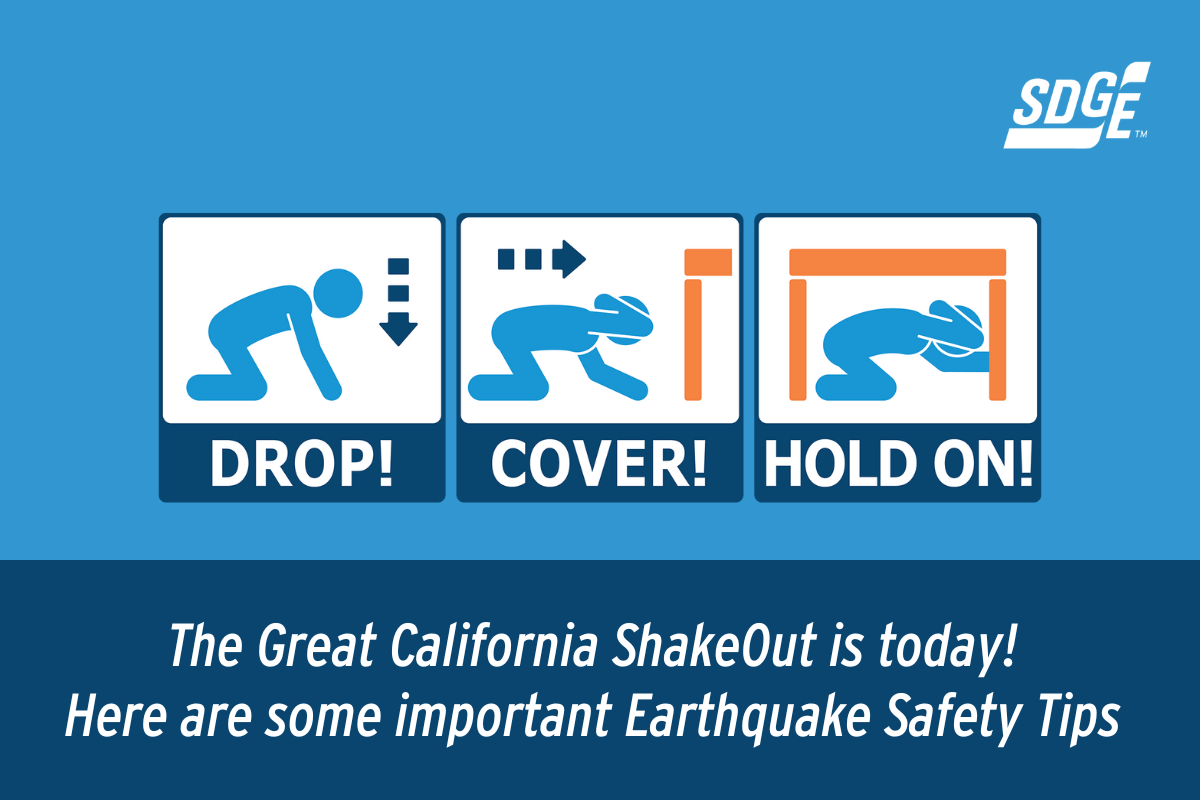As millions of Californians drop, cover and hold on today at 10:20am as part of the 15th annual statewide earthquake drill, Great California ShakeOut, here are some important tips from ShakeOut.org that customers should know to help them stay safe before, during and after an earthquake.
Before: Plan for an Earthquake
-
Have an emergency plan.
-
Secure furniture and large appliances.
-
Identify safe spots in each room, like sturdy tables and desks.
-
Identify dangerous spots near windows, mirrors, and hanging objects.
-
Learn how to shut off gas, water, and electricity.
During: Stay Safe
Federal, state, and local emergency management experts and other official preparedness organizations all agree that "Drop, Cover, and Hold On" is the best thing you can do to reduce injury and death during an earthquake (learn why here).
In most situations, if you feel shaking or get an earthquake alert, immediately:

DROP where you are, onto your hands and knees. This position protects you from being knocked down and reduces your chances of being hit by falling or flying objects.
COVER your head and neck with one arm and hand.
-
If a sturdy table or desk is nearby, crawl underneath for shelter.
-
If no shelter is nearby, crawl next to an interior wall.
-
Stay on your knees; bend over to protect vital organs.
HOLD ON until the shaking stops.
-
Under shelter: hold on to it with one hand; be ready to move with your shelter if it shifts
-
No shelter: hold on to your head and neck with both arms and hands.
Or adapt to your situation. If you have difficulty getting onto the ground, or cannot get back up again without help, then follow these recommendations:
If you use a cane: DROP, COVER, and HOLD ON or sit on a chair, bed, etc. and cover your head and neck with both hands. Keep your cane near you so it can be used when the shaking stops.
If you use a walker or wheelchair: LOCK your wheels (if applicable). If using a walker carefully, get as low as possible. Bend over and COVER your head/neck with your arms, a book, or a pillow. Then HOLD ON until the shaking stops.
For other accessibility recommendations, see EarthquakeCountry.org/accessibility.
Other important safety tips:
-
Do not run outside. Trying to run in an earthquake is dangerous, as the ground is moving, and you can easily fall or be injured by debris or glass. Running outside is especially dangerous, as glass, bricks, or other building components may be falling. It is much safer to stay inside and get under a sturdy desk or table.
-
Do not get in a doorway. Once a widely discussed safety measure, studies have shown that doorways are not the safest place to be during a earthquake because they do not protect you from flying or falling objects.
-
If you are outside, move away from buildings, trees, streetlights, or powerlines.
-
If you are driving, pull over and stop away from buildings and trees.
-
If you are at the beach or along the coast, watch for the signs of a tsunami.
-
Be ready for aftershocks
Natural Gas Safety Tips
-
Check smoke and carbon monoxide detectors to make sure they are working properly.
-
Know where your gas meter is located and keep a 12-inch or giant adjustable wrench with your emergency supplies, near your building exit or next to your gas meter shut-off valve. Do not store the wrench on the gas meter or other gas piping.
-
Be prepared to turn off your natural gas meter but ONLY if you smell natural gas, hear the sound of natural gas escaping or see other signs of a leak – and ONLY if it is safe to do so. (Depending on how many customers are without natural gas service, it may take an extended period for SDG&E to turn your natural gas services back on.)
-
If you turn off gas to the meter, leave it OFF. Please do not turn it back on yourself. Interior gas piping and appliances should be inspected for possible damage before service can be safely restored.
-
Call SDG&E to turn the gas back on, relight the pilots and service your appliances. (Note that certain repairs may have to be performed by your plumber or heating contractor. However, only SDG&E field employees are allowed to turn on the gas to the meter.)
-
DO NOT ignite a flame or use any electrical appliances, light switches or other devices that can cause a spark until you are sure there are no gas leaks.
For more information on gas safety, please visit sdge.com/safety/gas-safety. For more earthquake preparedness safety tips or to learn about the Great ShakeOut visit shakeout.org.


